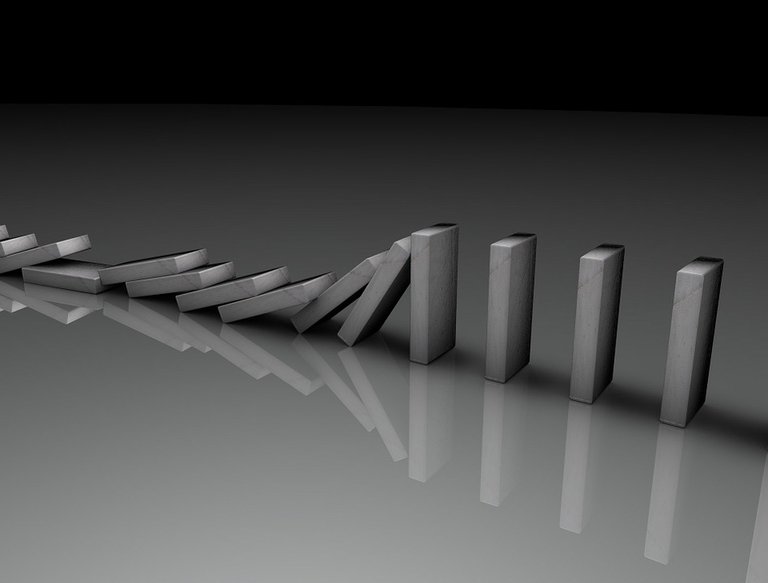 CC0 Creative Commons
CC0 Creative Commons
Preamble
This is not a scientific post, but just an imaginative comparison, a personal way to understand and explain, with own limits of knowledge, one of the many physical phenomena that surround us and that directly or indirectly regulate our lives.Premessa
Questo non è un post scientifico, ma solo un paragone di fantasia, un modo personale di spiegarsi, da “non addetto ai lavori”, e nei limiti di conoscenza, uno dei tanti fenomeni fisici che ci circondano e che direttamente o indirettamente regolano le nostre vite.
You may be wondering what do light (speed) and the domino tiles have in common, the question is plausible and the answer is that they probably have nothing, but the unusual comparison came to my mind while trying to understand one of the many (apparent) paradoxes of physics.
When I learned that the light speed is always the same, regardless of the motion of its source of propagation, I remained a bit weirded out: how is it possible?
If at the same instant, and with the same force, a boy placed on the ground and another boy placed into a carriage of a running train kick a ball (I know, I have never seen people playing football in a train either but the example is a case in point like the tower of Pisa, the elevator, etc..), an observer on the ground would see the ball on the train moving faster than the ball on the ground, because the initial speed of the train is added to thee speed of the ball. Why is it not the same for the light?
As I’m not a physicist I tried to imagine how something that apparently goes against logic can be possible.
And so, instead of planets, stars, towers of Pisa, elevators and inertial or non-inertial reference systems, the domino tiles came to my mind, more specifically their sequential, unchanging and constant fall mechanism, as a similitude with the electromagnetic radiation in the vacuum. The propagation of the light must have something similar to this mechanism.
When I learned that the light speed is always the same, regardless of the motion of its source of propagation, I remained a bit weirded out: how is it possible?
If at the same instant, and with the same force, a boy placed on the ground and another boy placed into a carriage of a running train kick a ball (I know, I have never seen people playing football in a train either but the example is a case in point like the tower of Pisa, the elevator, etc..), an observer on the ground would see the ball on the train moving faster than the ball on the ground, because the initial speed of the train is added to thee speed of the ball. Why is it not the same for the light?
As I’m not a physicist I tried to imagine how something that apparently goes against logic can be possible.
And so, instead of planets, stars, towers of Pisa, elevators and inertial or non-inertial reference systems, the domino tiles came to my mind, more specifically their sequential, unchanging and constant fall mechanism, as a similitude with the electromagnetic radiation in the vacuum. The propagation of the light must have something similar to this mechanism.
Vi starete chiedendo cosa possano avere in comune le tessere del domino e la luce, la domanda è plausibile e la risposta è che probabilmente non hanno nulla, ma l’insolito paragone mi è venuto in mente per cercare di comprendere uno dei tanti (apparenti) paradossi della fisica.
Quando appresi che la velocità della luce è sempre costante indipendentemente dal moto della sua fonte di propagazione rimasi un po’ interdetto: come è possibile?
Se nello stesso istante, e con la stessa forza, un ragazzo calcia un pallone a terra e un altro ragazzo lo calcia in una carrozza di un treno in corsa (lo so, nemmeno io ho mai visto gente giocare a pallone in treno ma l’esempio è gettonato come la torre di Pisa, l’ascensore, ecc..), un osservatore a terra vedrebbe il pallone del ragazzo sul treno viaggiare più velocemente di quello a terra, perchè la velocità iniziale del treno si somma a quella del pallone calciato. Perchè ciò non avviene anche per la luce?
Non essendo un fisico ho provato ad immaginare come qualcosa che va apparentemente contro la logica possa essere possibile.
E così, invece di pianeti, stelle, torri di Pisa, ascensori e sistemi di riferimento inerziali e non, mi sono venute in mente le tessere del domino, più in particolare il loro meccanismo di caduta sequenziale, immutabile e costante, come similitudine con la radiazione elettromagnetica nel vuoto. La propagazione della luce deve avere qualcosa di simile a tale meccanismo.
Quando appresi che la velocità della luce è sempre costante indipendentemente dal moto della sua fonte di propagazione rimasi un po’ interdetto: come è possibile?
Se nello stesso istante, e con la stessa forza, un ragazzo calcia un pallone a terra e un altro ragazzo lo calcia in una carrozza di un treno in corsa (lo so, nemmeno io ho mai visto gente giocare a pallone in treno ma l’esempio è gettonato come la torre di Pisa, l’ascensore, ecc..), un osservatore a terra vedrebbe il pallone del ragazzo sul treno viaggiare più velocemente di quello a terra, perchè la velocità iniziale del treno si somma a quella del pallone calciato. Perchè ciò non avviene anche per la luce?
Non essendo un fisico ho provato ad immaginare come qualcosa che va apparentemente contro la logica possa essere possibile.
E così, invece di pianeti, stelle, torri di Pisa, ascensori e sistemi di riferimento inerziali e non, mi sono venute in mente le tessere del domino, più in particolare il loro meccanismo di caduta sequenziale, immutabile e costante, come similitudine con la radiazione elettromagnetica nel vuoto. La propagazione della luce deve avere qualcosa di simile a tale meccanismo.
 CC0 Creative Commons
CC0 Creative Commons
So let’s imagine that from point A to point B the space is filled with two parallel rows of domino tiles which are positioned at the same distance from one another and arranged in a straight line; then let's say that the sources of propagation (or fall tiles trigger) are represented by two balls traveling at different speeds, finally that the speed of light is expressed by the progress of the fall of the tiles once the first is pushed.
Now, if the two balls touched the first tile at the same time, although one of them travels faster than the other and as far as this motion can be fast, it will never exceed the rate of fall (speed) of the tiles, which we have said representing the speed of light. So we will see the last tile of both rows touching "ground" at the same time.
The comparison light - tiles fall could be related to the example of two people traveling at different speeds along two parallel lines and turning on a torch at the same time when they are aligned: the observer who is facing them at a certain distance will see both torches turning on at the same time.
This example made me understand why the speed of light and the one of its source of propagation cannot be added.
I hope you will appreciate this post.
Cheers.
Now, if the two balls touched the first tile at the same time, although one of them travels faster than the other and as far as this motion can be fast, it will never exceed the rate of fall (speed) of the tiles, which we have said representing the speed of light. So we will see the last tile of both rows touching "ground" at the same time.
The comparison light - tiles fall could be related to the example of two people traveling at different speeds along two parallel lines and turning on a torch at the same time when they are aligned: the observer who is facing them at a certain distance will see both torches turning on at the same time.
This example made me understand why the speed of light and the one of its source of propagation cannot be added.
I hope you will appreciate this post.
Cheers.
Immaginiamo pertanto che dal punto A al punto B lo spazio sia puntellato da due file parallele di tessere del domino posizionate alla stessa distanza l’una dall’altra e disposte in linea retta; poniamo poi che le fonti di propagazione (o innesco caduta tessere) siano rappresentate da due palline che viaggiano a velocità diverse, infine che la velocità della luce sia espressa dal progredire della caduta delle tessere una volta spinta la prima.
Ora, se le due palline toccassero la prima tessera nello stesso istante, per quanto una di esse viaggi più rapidamente dell’altra e per quanto questo moto possa essere veloce, non potrà mai superare il ritmo di caduta (velocità) delle tessere, che abbiamo detto rappresentare la velocità della luce. Avremo quindi che l’ultima tessera di entrambe le file toccherà “suolo” nello stesso istante.
Il paragone luce - caduta tessere potrebbe essere traslato all’esempio di due persone che viaggiano a velocità diverse lungo due linee parallele e che accendono una torcia nello stesso istante quando si trovano allineati: l’osservatore che si trova di fronte ad essi ad una certa distanza vedrà entrambe le torce accendersi nello stesso momento.
Questo esempio mi ha fatto comprendere perchè la velocità della luce e quella della sua fonte di propagazione non possono essere sommate.
Spero che il post vi sia piaciuto.
A presto!
Ora, se le due palline toccassero la prima tessera nello stesso istante, per quanto una di esse viaggi più rapidamente dell’altra e per quanto questo moto possa essere veloce, non potrà mai superare il ritmo di caduta (velocità) delle tessere, che abbiamo detto rappresentare la velocità della luce. Avremo quindi che l’ultima tessera di entrambe le file toccherà “suolo” nello stesso istante.
Il paragone luce - caduta tessere potrebbe essere traslato all’esempio di due persone che viaggiano a velocità diverse lungo due linee parallele e che accendono una torcia nello stesso istante quando si trovano allineati: l’osservatore che si trova di fronte ad essi ad una certa distanza vedrà entrambe le torce accendersi nello stesso momento.
Questo esempio mi ha fatto comprendere perchè la velocità della luce e quella della sua fonte di propagazione non possono essere sommate.
Spero che il post vi sia piaciuto.
A presto!
Bravo, bel post!!